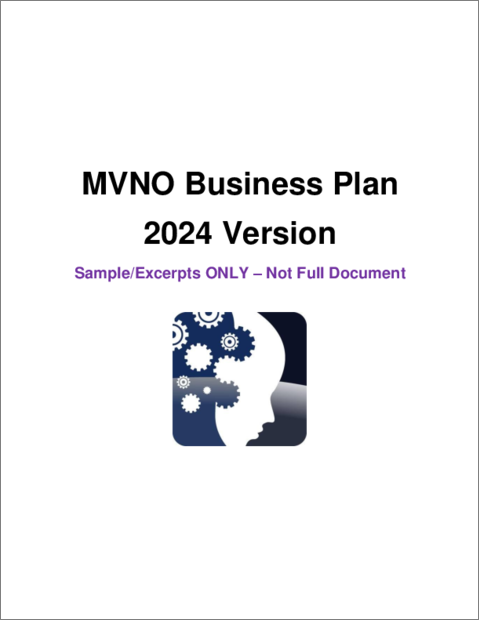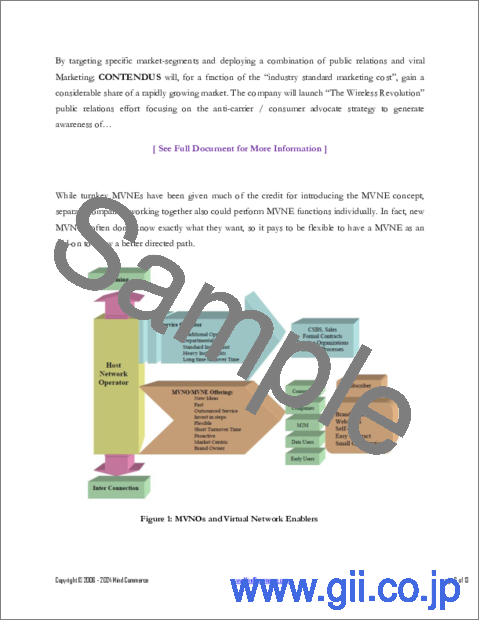|
|
市場調査レポート
商品コード
1622823
MVNOのビジネスプラン:2024年MVNO Business Plan 2024 |
||||||
|
|||||||
| MVNOのビジネスプラン:2024年 |
|
出版日: 2024年12月26日
発行: Mind Commerce
ページ情報: 英文 139 Pages
納期: 即日から翌営業日
|
全表示
- 概要
- 目次
仮想移動体通信事業者 (MVNO) はさまざまな理由で設立されますが、その多くはMVNO事業そのものよりも、他のビジネスと関係であることが多いです。MVNOが市場機会を開拓するために採用する戦略を検討し、MVNOのビジネスプランに盛り込むことが重要です。
検討される質問:
- MVNOは既存事業のサブブランドとなるか?
- MVNOは他の事業の小売戦略と連携するか?
- MVNOは、既存の移動体通信事業者 (MNO) に比べて割安なサービスを提供するか?
- MVNOは、消費者向けサービスではなく、B2BベースのM2M通信関連サービスを提供するか?
- MVNOはMNOからデータのみを取得し、メッセージングとボイスオーバーIPに依存し、OTTモデルで提供するか?
全体的なMVNO戦略がどんなであろうと、ビジョンを実行するには慎重な計画が必要です。成功したMVNOに共通しているのは、綿密に練られたビジネスプランからスタートしていることです。これには、5G技術のアベイラビリティが事業運営に与える最近の影響に関する洞察が含まれてる必要があります。本レポートからは、5Gベースのソリューションとサービス、ネットワーク、アプリ、サービスへの影響を評価すた調査結果を得ることができます。
MVNOのビジネスプラン
本レポートは、ContendusというMVNOの立ち上げを想定した完全なビジネスプランです。この計画は、市場評価、資金調達要件、財務分析、市場セグメンテーション、製品の差別化など、企業立ち上げ計画のあらゆる側面をカバーしています。また、市場参入計画、流通・補充計画、MVNOの比較なども含まれています。本レポートの主な利点は、MVNOの立ち上げの開発を支援し、既存の計画を検証するのに役立つことです。
本レポートでは、公共安全の中核技術とソリューション、5G、AI、IoTを含む重要通信の新たな主要分野を評価しています。また、企業、産業、政府部門向けの超高信頼性低遅延通信など、ミッションクリティカルな通信の新たな分野についても評価しています。
目次
第1章 エグゼクティブサマリー
第2章 概要
- 事業の焦点
- 事業戦略
- 市場
- 経営陣
- 財務状況
- 会社の使命
- MVNO基準
- 例外
第3章 事業
- 要件分析
- サービス内容
- ターゲット市場
- 初期サービス:主な収益源
- 将来の潜在的なサービス:追加の収入源
- 配送、購入、補充
- スターターパッケージ
- 端末とハードウェア
- LTEシステムとSIMカード
- ウェブサイトとユーザーインターフェース戦略
- LTEの強化、5G、将来の技術
- バックオフィスとカスタマーケア
- モバイルネットワークオペレータの要件
- 規制上の問題
- 解約に関する考慮事項
第4章 機会
- 機会
- 戦略
- プロビジョニングと管理
- インフラ
- マルチIMSIアプローチ
- マルチネットワークVPN
- セキュリティと制御
- 予測
第5章 市場
- 米国のワイヤレス市場
- プリペイドサービス市場
- 卸売通信サービス
- 交渉に不可欠な要素
- セットアップコスト分析
- 端末の使用と制御
- ネットワークの使用と制御
- 5GとMVNO
第6章 マーケティング計画
- 概要
- マーケティング戦略
- 初期の市場セグメントと戦略的考慮事項
- 提携と共同ブランド
- ロイヤルティプログラム
- 移行戦略
第7章 財務概要
- 収益源とコストの考慮
- 収益成長
- 財務予測
- 資金調達
- 出口戦略
- 財務モデリング
第8章 拡張機能とアップグレード
- 選考基準
- 技術要件
- その他の要因
第9章 潜在的市場セグメント
第10章 マネジメントチームとパートナー
- 管理
- 諮問委員会
- オペレーションパートナー
第11章 競合
- プリペイド企業
- プリペイド市場の評価
第12章 MVNO市場の展望
- 概要
- 世界の展望・予測
- 欧州のMVNOの推進因子
- 米国のMVNOの推進因子
- 中東のMVNOの推進因子
- アジア太平洋地域のMVNOの推進因子
第13章 MVNOのケーススタディ
第14章 総論
第15章 付録
Overview:
Mobile Virtual Network Operator (MVNO) companies are launched for many different reasons, many of which have more to do with other businesses than the MVNO operation itself. It is important to consider the strategies the MVNO will employ to exploit market opportunities and include in an MVNO Business Plan.
Some questions to consider include:
- Will the MVNO be a sub-brand to an existing business?
- Will the MVNO align with the retail strategies of some other business?
- Will the MVNO offer discounted services compared to existing Mobile Network Operators (MNO)?
- Will the MVNO offer Machine-to-Machine (M2M) communications-related services on a B2B basis rather than consumer services?
- Will the MVNO acquire data only from the underlying MNO, relying upon messaging and voice-over IP and delivered in an OTT model?
Regardless of the overall MVNO strategy, executing upon a vision requires careful planning. One thing that all successful MVNOs have in common is they started with a well-developed business plan. This must include insights regarding the recent impact of 5G technology availability on business operations. Accordingly, customers acquiring the MVNO Business Plan will also receive research evaluating 5G-based solutions and services and its impact upon networks, apps, and services.
The MVNO Business Plan
This is a full business plan based on the launch of an illustrative MVNO known as Contendus. The plan covers all aspects of the company launch plan including market assessment, funding requirements, financial analysis, market segmentation, and product differentiation. Also included is a go-to-market plan, distribution and replenishment plans, comparison of MVNOs, and more. The major benefit of this report is to assist in the development of an MVNO launch and to help validate existing plans.
Launching an MVNO involves a lot of careful planning and an understanding of the competitive threats and opportunities. Understanding the competitive issues and what type of MVNO to launch is key to success. A critical aspect to the success of any MVNO is its wholesale negotiations with the host mobile network operator (MNO).
With 5G poised to impact virtually every part of the communication services value chain, the publisher believes it is extremely important for the MVNO ecosystem to be informed and understand the impacts on virtual network operations. Accordingly, a thorough analysis of the impact of 5G on MVNOs is included.
Target Audience:
- MVNO start-ups
- Mobile network operators
- MVNE/MVNO service providers
- Investors and analysts in the mobile space
- Suppliers of MVNO equipment and software
- Consultants and systems integration companies
The market for mission-critical communications is rapidly evolving as developing technologies supply solutions necessary to meet emerging demand for improved voice, data, and machine-oriented communications. Industry verticals that manage critical infrastructure (such as utilities, ports, and transportation) also require enhanced communications to safeguard assets and optimize operations.
We see a few technologies playing a key role including 5G, Artificial Intelligence, and Internet of Things (IoT) solutions. In addition, there is a strong opportunity for network and system integration as otherwise disparate solutions converge in a manner in which operations management does not become onerous.
This report evaluates core public safety technology and solutions as well as emerging key areas for critical communications including 5G, AI, and IoT. This report also assesses emerging areas for mission critical communications including ultra-reliable low-latency communications for enterprise, industrial, and government sectors.
Table of Contents
1. Executive Summary
2. Overview
- 2.1. Business Focus
- 2.2. Business Strategy
- 2.3. The Market
- 2.4. The Management
- 2.5. The Financials
- 2.6. The Company Mission
- 2.7. MVNO Criteria
- 2.8. Exceptions
3. The Business
- 3.1. Requirements Analysis
- 3.2. Description of Services
- 3.3. Target Market
- 3.4. Initial Services: Primary Revenue Drivers
- 3.5. Potential Future Services: Additional Revenue Sources
- 3.6. Distribution, Purchasing and Refills
- 3.7. Starter Package
- 3.8. Handsets and Hardware
- 3.9. LTE System and the SIM-card
- 3.10. Website and User Interface Strategies
- 3.11. LTE Enhancements, 5G, and Future Technologies
- 3.12. Back-Office and Customer Care
- 3.13. Mobile Network Operator Requirements
- 3.14. Regulatory Issues
- 3.15. Churn Considerations
4. The Opportunity
- 4.1. Opportunity
- 4.2. Strategy
- 4.3. Provisioning and Management
- 4.4. Infrastructure
- 4.5. Multi-IMSI Approach.
- 4.6. Multi-network VPN
- 4.7. Security and Control
- 4.8. Forecast
5. The Market
- 5.1. US Wireless Market
- 5.2. Prepaid Services Market
- 5.3. Wholesale Communications Services
- 5.4. Essential Negotiation Factors
- 5.5. Set-up Cost Analysis
- 5.6. Terminal Usage and Control
- 5.7. Network Usage and Control
- 5.8. 5G and MVNOs
6. Marketing Plan
- 6.1. Overview
- 6.2. Marketing Strategy
- 6.3. Initial Market Segments and Strategic Considerations
- 6.4. Partnering and Co-branding
- 6.5. Loyalty Program
- 6.6. Migration Strategy
7. Financial Overview
- 7.1. Revenue Streams and Cost Considerations
- 7.2. Revenue Growth
- 7.3. Financial Projections
- 7.4. Funding
- 7.5. Exit Strategy
- 7.6. Financial Modeling
8. Extensions and Upgrades
- 8.1. Selection Criteria
- 8.2. Technical Requirements
- 8.3. Other Factors
9. Potential Market Segments
10. The Management Team and Partners
- 10.1. Management
- 10.2. Board of Advisors
- 10.3. Operational Partners
11. Competition
- 11.1. Prepaid Players
- 11.2. Prepaid Market Assessment
12. MVNO Market Outlook
- 12.1. Overview
- 12.2. Global Outlook and Forecast
- 12.3. MVNO Drivers in Europe
- 12.4. MVNO Drivers in the United States
- 12.5. MVNO Drivers in the Middle East
- 12.6. MVNO Drivers in Asia Pacific
13. MVNO Case Studies
14. Conclusions
15. Appendix
- 15.1. Cellular Operator Organization Structure
- 15.2. Initiating Contact with MNOs
- 15.3. Strategy Development
Figures:
- Figure 1: MVNOs and Virtual Network Enablers
- Figure 2: MVNO Business Model
- Figure 3: Advanced LTE-based Applications
- Figure 4: Value-add Service Applications
- Figure 5: MVNO Network Planning with MNO
- Figure 6: MVNO Categorization by Business Model Segmentation
- Figure 7: 5G Network Slicing and Virtual Networks
- Figure 8: MVNO OSS/BSS Planning
Tables:
- Table 1: MVNO Type and Infrastructure Mapping
- Table 2: MNO vs. MVNO Characteristics
- Table 3: Customer Churn Analysis
- Table 4: MVNO Marketing Strategy
- Table 5: End-User Forecasts
- Table 6: Pro Forma Income Statement
- Table 7: SWOT Analysis
- Table 8: USA vs. Europe Comparative Analysis
- Table 9: Prepaid Penetration Assessment
- Table 10: Prepaid Services Distribution and Replenishment





